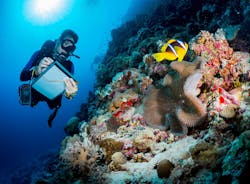DARPA eyes harvesting electric power from microscopic sea life like phytoplankton to power ocean sensors
ARLINGTON, Va. – U.S. military researchers are approaching industry to develop ways to harvest energy from microscopic sea life like dissolved organic matter, phytoplankton, bacteria, and microscopic zooplankton into electric power.
Officials of the U.S. Defense Advanced Research Projects Agency (DARPA) in Arlington, Va., issued a broad agency announcement (HR001124S0010) last week for the BioLogical Undersea Energy (BLUE) program.
BLUE seeks to develop self-refueling electric power generation that enable remote ocean sensors like seabed-mounted sensor and profiling systems to operate far longer than possible by batteries alone.
BLUE will demonstrate a persistent, sustainable, low-environmental-impact source of electric power that provides ultralong endurance and high payload capacity to remote ocean sensors, which hold great potential for national security, understanding dynamics of marine environments, and monitoring marine climate change.
Today the vast majority of these systems are powered by batteries, which provide relatively low endurance, and are difficult and expensive to maintain. BLUE, on the other hand, could offer transformative and significant improvements over state-of-the-art batteries and other types of power supplies by enabling high capability and long endurance.
BLUE technologies will self-refuel on input materials, which are readily available in many marine environments; prevent capture of macroscopic living marine organisms; operate while submerged; will be durable, reliable, deployable; operate in diverse locations; operate independently with consistent electrical power production; and have negligible ecological and environmental impact.
BLUE contractors will choose input materials like dissolved organic matter, phytoplankton, and zooplankton as input materials to convert to electrical power.
Each performer team will develop two separate system prototypes that self-capture and convert input materials to electrical power while fully submerged without user intervention.
BLUE power supplies must interface with the marine environment without corrosion and fouling of internal components. The 30-month BLUE program will have a 21-month first phase and a nine-month second phase.
DARPA will brief industry on BLUE program details during a virtual industry day on 29 Feb. 2024. Companies interested should register for the industry day no later than Monday 26 Feb. 2024 online at https://events.sa-meetings.com/BLUEPD.
Companies interested in participating in the BLUE program should email abstracts no later than 14 March 2024, and full proposals no later than 30 April 2024 to the DARPA BAA website online at https://baa.darpa.mil.
Email questions or concerns to Leonard M. Tender, the DARPA BLUE program manager, at [email protected]. More information is online at https://sam.gov/opp/78e3b1374f5b415c82cc2c85d54a8481/view.
